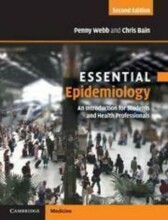Summary: Hnh Introduction To Epidemiology And Public Health
- This + 400k other summaries
- A unique study and practice tool
- Never study anything twice again
- Get the grades you hope for
- 100% sure, 100% understanding
Read the summary and the most important questions on HNH Introduction to epidemiology and public health
-
College 2
This is a preview. There are 4 more flashcards available for chapter 09/09/2019
Show more cards here -
Explain and give an example of a cumulative incidence/incidence proportion calculation
- Measures the proportion of people who develop the disease during a specified period (NEW cases)- Number of people who develop disease in a specified period / Number of people at risk of getting the disease at the start of the period
- Condition: complete follow-up, no competing mortality
7 deaths
5 nothing
12 in total
7/12 = 0.58 --> average risk in population is 58% -
How do you calculate the incidence rate?
- Incidence rate/mortality rate/incidence density- Number of people who develop disease / Number of person years when people were at risk of getting the disease
24.5 time at risk (calculate how many people where at risk at what time)
2 deaths
2/24.5 = 0.082 person-year -
What is a proportion and what is a rate?
- Proportion- Number of people in the denominator
- One number / another number + one number = total number
- Always a ratio, between 0 and 1
- Has person-time in the denominator
- One number / another number
- Not all ratios are proportions
-
What is the case fatality ratio?
- Proportion of people with a given disease who die from it in a given period (usually < 1 month)
- Measure of the short term severity of an acute disease
- Number of deaths from a disease in a specified period / Number of people diagnosed with the disease in same period -
In a community with a population of 50.000 people, 27 developed diabetes during a 2 year period. Calculate the measure of incidence and identify what type of measure it is.
- Incidence rate- 27 / 50.000 * 2 = 27 / 100.000 person-years
- 27 / 50.000 * 2 = 27 / 100.000 person-years
-
When do you use incidence and prevalence?
- Incidence is generally used for acutely acquiered diseases, prevalence is used for more permanent states, conditions or attributes of ill-health
- Incidence is more important when thinking of etiology of the disorder, prevalence when thinking of societal burden of the disorder including the costs and resources consumed as a result of the disorder
- Incidence is generally used for acutely acquiered diseases, prevalence is used for more permanent states, conditions or attributes of ill-health
-
What was the prevalence of high blood pressure at age 55? (in %)What was the prevalence of high blood pressure at age 65? (in%)How many women were at risk of high blood pressure at the start of the 10 year period?What was the incidence of high blood pressure in these women? (% in 10 years)Is this an incidence proportion or an incidence rate?
- 100/2000=0.05 --> 5%
- 400/2000=0.2 --> 20%
- 2000-100 (already had it) = 1900
- 300/1900=0.16 --> 16% in 10 years
- IP: these same women have been followed for 10 years
-
Assume that, on average, each of these women who developed high blood pressure did so half-way during the 10-year follow-up period.Calculate the total number of person-years at risk (of developing high blood pressure) during the 10 yearsWhat was the incidence rate of high blood pressure in these women?
1. 300 women developed HBP x 5 years = 1500
1600 women without HBP x 10 years = 16.000
In total: 17.500 person years
2. 300/17.500 = 1714/100.000 = 17,1 per 1000 person-years -
Tell more on incidence, prevalence and the duration of the disease
- Prevalence varies directly with both incidence and duration
- If incidence is low, but duration is long (chronic), prevalence will be large in relation to incidence
- If prevalence is low because of short duration (due to recovery, migration or death), prevalence will be small in relation to incidence
Prevalence = incidence x duration
What influences prevalence and incidence figures?- Risk factors, type of population, genetic background
- Disease duration, medicale treatment, cure
- Risk of dying from the disease, case fatality
- Detection, diagnosis, awareness (patients & doctors)
- Disease coding and registratrion systems
- Contagiousness, transmission of disease, hygiene, population density
-
College 3
This is a preview. There are 2 more flashcards available for chapter 10/09/2019
Show more cards here -
What influences COPD?
Genetic susceptibility- Genetic variants associated with lung function
- Epigenome is link between the inherited genome and environmental exposures
- Exposure to cigarette smoke, air pollution and job-related exposures
- Higher grades + faster learning
- Never study anything twice
- 100% sure, 100% understanding




























